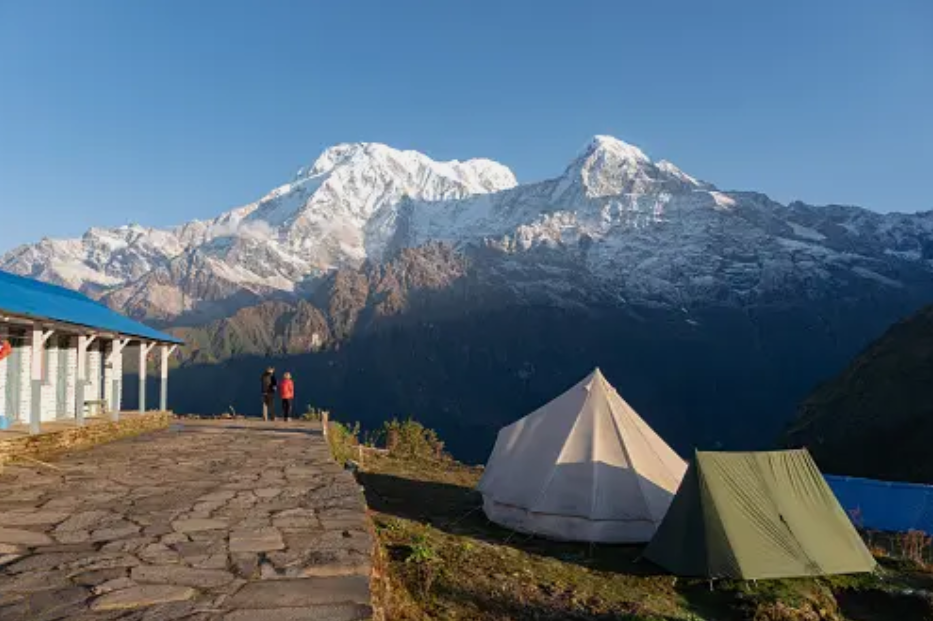Trip Info
Overview
Mardi Himal is a short and lesser-known trekking destination of Nepal. Mardi Himal a 5,587-meter peak, lies in the Gandaki zone, east of the Annapurna region beneath the prominent Macchapuchre. The base camp itself lies at an altitude of 4500m. It was first submitted in 1961 by Basil Goodfellow. It was opened officially in 2012, along with the establishment of many teahouses or lodges. This trek offers an amazing view of snow-capped mountains like Annapurna, Dhaulagiri, Macchapuchre, and Manaslu ranges. The trail to Mardi Himal passes through Australian camp, Pothana, Mardi Himal base camp, siding village, and Lwang. This area is highly protected by Annapurna Conservation Area where you can witness several Flora and Fauna. You also get to see the beautiful Rhododendron and oak forests, beautiful lakes, and waterfalls. The trek basically gives us an amazing experience with many Magar and Gurung people.
Temperature and weather
Talking about the temperature of the Mardi Himal base camp, you need to know there are two destinations, Mardi Himal lower base camp and Mardi Himal high base camp.
Mardi Himal Lower base camp– It lies at an altitude of 2990m, and the maximum temperature here is around 21 while the lowest can be -2. The weather is comparatively warmer in the lower base camp. The spring season in Mardi Himal lower base camp is mesmerizing. Having different Flora and Fauna including Lichens, orchids, Oaks, and ferns, the spring season also offers botanical educational values.
Mardi Himal high base camp– It lies at an altitude of 3,580. The maximum temperature here can be 17⁰C while the lowest can be -2⁰C. Passing through the high Alpine forest the trails to the high base camp looks amazingly beautiful.
Considering all the favorable temperature and climatic conditions of the Annapurna region, autumn (September, October) and November) and spring (March-May) would be best for the trekkers. These seasons particularly provide you with clear and blue skies. December – January would be suitable for those who like fewer people or don’t want the crowd. But one has to be aware that it might be very difficult to find accommodation and food at this time since the places might be closed or off-season.
Food and accommodation– Mardi Himal trek is entirely a teahouse trek. No camping is necessary unless you want to experience it. There are enough teahouses throughout the way to Mardi Himal. The teahouses are basically run by local people. They have basic facilities like a warm room, blankets, and pillows. But they have to be shared with other trekkers as well. Also, the washroom and toilets have to be shared. Sometimes, you can get a single room with attached bathrooms. They also provide home-cooked meals like Dal, Bhat, vegetables, noodles, pasta, soup, and western food. Tea, coffee, soft drinks, hot chocolates, etc are also available on the teahouses. Staying in teahouses or lodges may cost up to 5- 10$ (500 -1000 NRS) per night. Teahouses have proper facilities of bathroom, hot shower, and internet access.
Electronics and communication
The facilities here are quite minimum or limited in comparison to other places on Annapurna. However, they have electricity to charge your electronics or phones. Wi-Fi may not be available in all lodgings or you may have to pay extra for those. However, a telephone tower has been set up at high camp. Furthermore, the 2G and 3G networks are available. So you can now call anytime and also have access to the internet through data.
Getting to Mardi Himal
The gateway to the Mardi Himal trek is Pokhara. You can take a bus from Kathmandu to Pokhara which only takes 4-5 hours. From Pokhara, again take a bus to Kande through the Baglung highway. From Kande, you need to hike to the Australian Base camp and further.
Permits and fees
Annapurna Conservation Area
SAARC countries- 1500 NRS (15$), excluding VAT
NON-SAARC countries- 3000 NRS (30$), excluding VAT
TIMS- 1000 NRS (10$)
You can easily get these permits from any travel agency or Nepal Tourism Board
Guides and porters
Guides and porters are not really mandatory since it is an easy and short trek but they can make your journey informative and interesting. They have more than enough knowledge about the directions, villages, places, accommodations, etc. Guides usually charge 25-30 $ per day. If you are physically able to carry your belonging then there is no need for a porter. If you want to walk freely without any burden you can hire a guide. They usually charge 15-20$ per day.
Safety and difficulties of EBC
Mardi Himal trek is a short and relatively easy trek. However, it does come with a few challenges. The road from the Australian base camp is steep and rugged. The level of difficulty entirely depends on your physical and mental fitness. But you can build your muscle strength, make your body flexible by practicing some light exercise, running, and jogging. The trek to Mardi Himal is all about walking 5-6 hours per day for at least 1 week which can make this trek slightly challenging. The trails are rugged, steep, maybe snowy in off-seasons. The maximum height in this trek is the base camp 4500m with other high passes on the way. There is a high risk of mountain sickness. The primary cause of altitude sickness is a decrease in the amount of oxygen in the atmosphere. It’s important to carry handheld oximetry. Oxygen saturation below 75% may be a risk.
*Symptoms of Mountain sickness
-Headache
-Dizziness
-Loss of appetite
-Shortness of breath
-Fast heartbeats
*Preventing mountain sickness
-Walk slow
-Stay hydrated
-Have nutritional food
-Have enough rest
-Avoid smoking and alcohol
*Medicines for mountain sickness
-Acetazolamide
-Ibuprofen, paracetamol (for headache)
-Promethazine (for nausea)
Other requirements
Travel insurance– Trekking to high altitudes can always be risky. Travel Insurance is something you might want to do before trekking anywhere. Sometimes in emergency cases, people need to be evacuated through a helicopter and get medical service. So, in such cases, your travel insurance will be bearing the cost for you. Seeing all these benefits, the government of Nepal has made travel insurance mandatory thing before trekking. However, it is very important to mention the heights and all the places you will be reaching during your trek. Your insurance entirely depends on the details you have provided earlier. Travel insurance costs you around 150$ which is good for 1 month.
Visas/passports– If you are not a Nepalese or Indian citizen, then a visa and a passport are mandatory. You can get your Nepalese Visa at Tribhuvan airport in Kathmandu. The passport must hold a visa of a minimum of 6 months.
Highlights
- Stunning views of Annapurna South, Hiunchuli, and other mountains
- Pass through colorful Rhododendron forest
- Experience the perfect teahouse trek.
- Enjoy the hospitality of the Gurung and Magar people.

